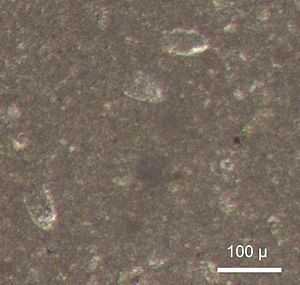Calpionella
| Calpionella | ||||||||||||
|---|---|---|---|---|---|---|---|---|---|---|---|---|

Calpionellids from Tithonic limestone from the Ardèche , France |
||||||||||||
| Temporal occurrence | ||||||||||||
| Upper Jura to Lower Cretaceous | ||||||||||||
| approx. 148 to 140 million years | ||||||||||||
| Locations | ||||||||||||
|
||||||||||||
| Systematics | ||||||||||||
|
||||||||||||
| Scientific name | ||||||||||||
| Calpionellida | ||||||||||||
| Bonet , 1956 |
Calpionella (Calpionellida), Greek κάλπις "water jug") are an extinct group of eukaryotic unicellular organisms of unknown systematic position from the Mesozoic ( Mesozoic Era).
Calpionellids were planktonic living, marine organisms in Tethysbereich during the period around the turn of the Upper Jurassic to Lower Cretaceous were quite frequent. In the past, they were often associated with the tintinnids , a group of ciliate animals.
description
Calpionellids are mainly in the pelagic deposited limestones ( "Calpionellenkalk") of Upper Jurassic and Lower Cretaceous relatively common microfossils . They are bell-shaped, calcitic housings with turned-up edges about 40 to 150 micrometers (µm) in length. The external shape differs from species to species, as does the shape and size of the folded edges. The wall consists of spirally arranged prismatic calcite crystals that are perpendicular to the wall surface. Housings that agglutinate foreign bodies into the wall also occur. As a rule, calpionella cannot be isolated from the rock, but are examined and determined with the help of thin sections .
meaning
From the Upper Jurassic Tithonium to the Lower Cretaceous Valanginium , the Calpionella have undergone rapid radiation and produced many short-lived species. This makes them important for biochronology or for the biostratigraphic structure of the layers that were deposited during this time and are valuable key fossils . Six calpionella zones are distinguished from the middle tithonium to the early valanginium , which can be further subdivided into 19 subzones.
Although the Calpionella are very dependent on the facies (“facies fossils”) and occur almost exclusively in the pelagic sedimentary rocks of the Tethys , they are very common and widespread there and do not show any endemisms . In addition, because of their calcitic casing, they can also be preserved below the ACD ( Aragonite Compensation Depth ), where the aragonitic casing of the ammonites has already dissolved.
history
The eponymous genus Calpionella was established by Lorenz (1901).
Systematics
There are currently two families :
- Colomiellidae Bonnet, 1956
- Calpionellidae Bonnet, 1956
literature
- Ulrich Lehmann: Paleontological Dictionary . 4th reviewed and expanded edition, 277 pages, Enke Verlag. Stuttgart 1996 ISBN 3-432-83574-4 .
- Erik Flügel: Microfacies Analysis of Limestones . 633 pp., Springer Verlag, Berlin, Heidelberg, New York 1982 ISBN 3-540-11269-3 .
Web links
- Joachim Blau & Beate Grün Proposal to revise the Calpionella zone and sub-zone classification
- Beate Grün and Joachim Blau Phylogeny, systematics and biostratigraphy of the Calpionellidae Bonet, 1956: new data from the Rosso Ammonitico Superiore and the Biancone (Upper Jurassic / Lower Cretaceous: Tithon - Valangin) by Ra Stua (Prov.Belluno, Italy)